 Test Yourself with Raven's Progressive Matrices - Sample Questions & Answers for SPM and APM
Test Yourself with Raven's Progressive Matrices - Sample Questions & Answers for SPM and APM
Updated: February 6th, 2025
Trusted by over 1,600 Candidates
The Raven's Progressive Matrices (RPM) Test is a high-level, non-verbal assessment used to estimate fluid intelligence (often referred to as the Raven's IQ Test).
On this page, you can test yourself with a free Raven's Progressive Matrices practice test, including sample questions and detailed answers for both the Standard (SPM) and Advanced (APM) versions. We’ll focus on the first two Raven's Matrices tests, with a special emphasis on APM. Let's get started!
What Users Are Saying About the Raven's Progressive Matrices Test – Real Reviews and Insights
Did You Know?
Raven's include three test types:
- Raven's Advanced Progressive Matrices Test (APM) – More intricate, typically about 23 questions in 40 minutes.
- Raven's Standard Progressive Matrices Test (SPM) – More moderate, typically 43 questions in 47 minutes.
- Raven's Coloured Progressive Matrices Test (CPM) – Used for young children and the elderly. Read about it in our dedicated page on Raven's Coloured Progressive Matrices
Raven's Advanced Progressive Matrices Test (APM)
The questions in this Raven's assessment test include a 3X3 matrix. You must identify the pattern and select the missing element to complete the bottom right slot. We will start with an easy example and then move on to more challenging progressive matrices. The Raven's Advanced Matrices will be included along with tips and insights on the Raven's Progressive Matrices Test, helping you tackle more difficult questions effectively.
Sample Question #1 - Progression Rule
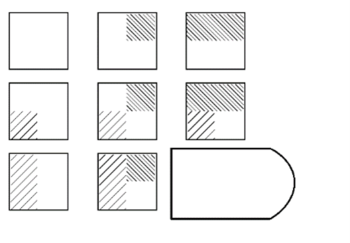

In Progression rule questions the object changes, or rather progresses with every step throughout the row or the column (the direction may vary).
Sample Question #2 - Motion Rule

In motion rule questions, the objects move (change their position) with each step. Usually, the motion is of one or more of the objects inside a frame. To identify the movement of the inner object, it is useful to compare the outer object or frames across either the rows or columns.
Sample Question #3 – Rotation Rule
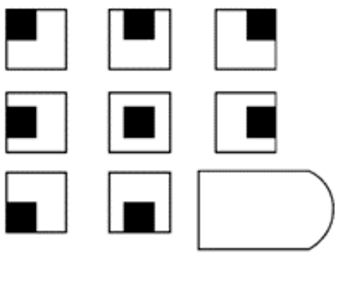
In rotation rule questions, the figures in the matrix rotate in a determined pattern across either rows or columns.
Sample Question #4 - Construction Rule
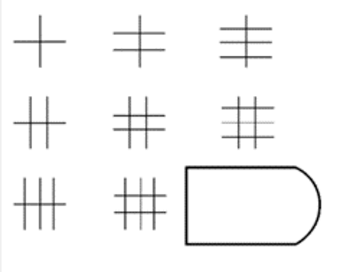
In construction rule questions, two objects from the same row or column are combined to form the third object. In simple matrices, this combination might look just like a simple addition equation.
Prepare for Raven’s Advanced Matrices with Confidence!
Begin practising today for only £49. Access hundreds of practice matrices and guides to ensure your success in abstract reasoning tests.
Sample Question #5
Observe the following progressive matrix and identify the pattern.
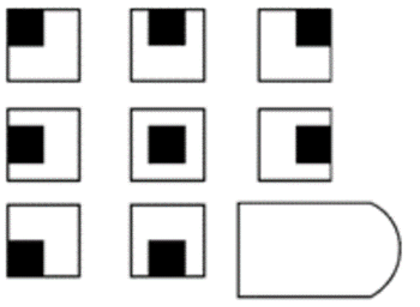
Which of the following is the missing piece?

Tip: How to Recognize Different Patterns?
When approaching spatial inductive questions – and especially progressive matrices, there is great importance in identifying different patterns quickly and accurately. Since time is short, and questions may become increasingly difficult – it is crucial not only to practise ahead but also to learn to recognize recurring patterns.
Recurring patterns may include figures (such as circles, triangles, and rectangles), moving clockwise/anti-clockwise, the direction of lines, and changing colours (mostly black or white). For Raven's Assessments, there will usually be one recurring pattern along the rows and another along the columns.
For example, the first Raven's Progressive Matrices question on this test consists of a basic, moving black square inside a large white square – which moves left-to-right along the rows, and up-and-down along the columns. The second example starts as a blank square (top left). As it descends down the rows, it adds diagonal lines for each step. It does the same as it moves left along the columns. Since the direction of the diagonal lines is opposite for rows and columns – you can quickly figure that the part of the square that includes lines from both rows or bottom will present a new, unique pattern, not yet seen.
Sample Question #6
Observe the following progressive matrix and identify the pattern.

Which of the following is the missing piece?

Ace Your Job Search with a Custom Prep Kit
Job hunting doesn't have to be stressful.
Prepare smarter and ace your interviews faster with our Premium Membership.



Sample Question #7
Observe the following progressive matrix and identify the pattern.
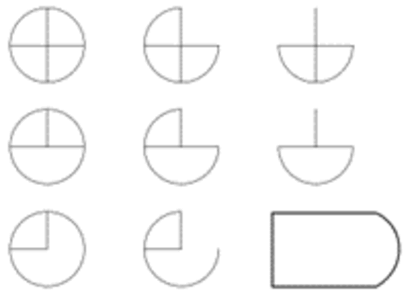
Which of the following is the missing piece?
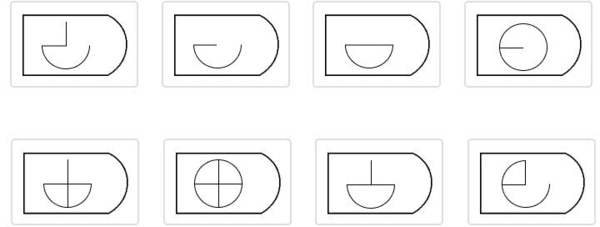
Tip: Eliminating Answers
Given the time- constraint often imposed on cognitive assessments, there is no shame in using elimination as a shortcut to the right answer. The same is true for Raven's Progressive Matrices.
Use the observed patterns to eliminate unlikely options. If you notice that the number of shapes is increasing, then any option with fewer or the same number of shapes can probably be eliminated. Try to mentally place the remaining options into the empty slot. Does it complete both the row and the column patterns? If so, you may have found your answer.
For the previous example, you can immediately eliminate the entire bottom row – which includes figures that already appeared in the matrix. Since the matrix shows a pattern of reduction, it is not plausible that a figure would appear twice. The advantage of this method is that even when you are uncertain of the answer and have to take a guess – it becomes an educated guess, and the chances of answering correctly increase.
Prepare for Raven's Test with Expert Guidance
With decades of proven experience, JobTestPrep helps you succeed in Raven's Test. Access expert tips, detailed solving strategies, and practice on hundreds of unique matrices—all for only £49.
Sample Question #8
Observe the following progressive matrix and identify the pattern.
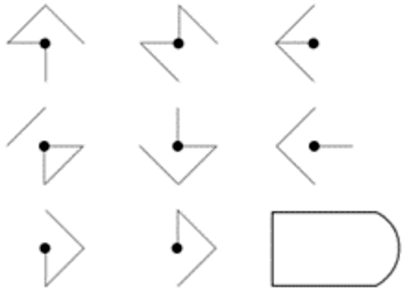
Which of the following is the missing piece?
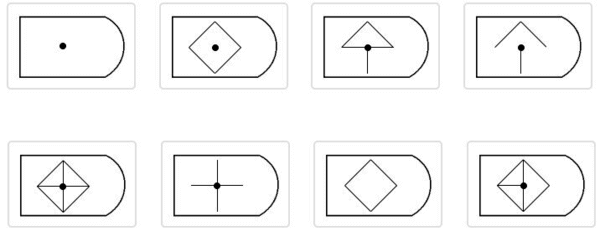
Raven's Advanced Progressive Matrices Test comes in a long version (23 questions in 40 minutes), or a shorter version (12 questions in 15 minutes). Either way, the questions vary in difficulty - their become increasingly more challengin due to nearing time limit, difficulty, and fatigue as the test progresses.
Raven's progressive matrices test, and the advance progressive matrices in particular, are the basis for many abstract reasoning tests, like the Talent-Q Elements, which is a very popular test.
The best way to succeed in the test is practise. Seeing, analysing, and responding to many different matrices and patterns is essential to success. You can find many of Raven's APM practise tests and, study guides, and detailed explanation with solving tips in our All-Inclusive Raven Matrices PrepPack.
Let's look at a couple of examples of the Raven's Standard Progressive Matrices (SPM) Test, which vary in format and difficulty:
Raven's Standard Progressive Matrices Test (SPM)
The questions in this aptitude test include either an image of different figures or patterns. You must identify what the missing figure is, in matrices of different sizes (i.e., 2X2). The Raven's SPM IQ Test is typically given to a younger population, and the SPM scores are accordingly evaluated against a norm group consisting of younger people.
Let's take a look at three standard progressive matrices:
Sample Question #9
Observe the following progressive matrix and identify the pattern.
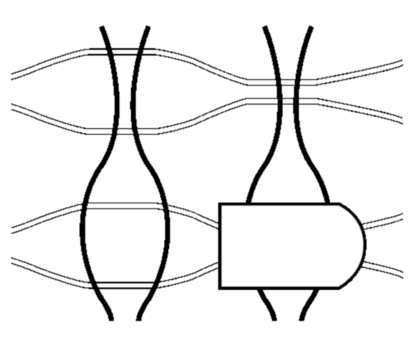
Which of the following is the missing piece?
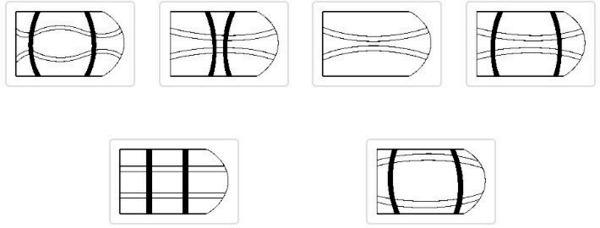
Sample Question #10
Observe the following progressive matrix and identify the pattern.

Which of the following is the missing piece?
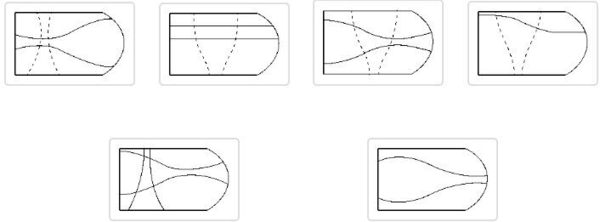
Sample Question #11
Observe the following progressive matrix and identify the pattern.

Which of the following is the missing piece?

How is Raven's Progressive Matrices Test Scored?
Scoring and interpretation for the Raven IQ Test is more complex than the typical calculation of a number of correct answers scores.
Each item has a level of difficulty and discrimination that is factored into the scoring. For example, suppose you answered properly the more difficult and discriminating questions in the test. In that case, you will obtain higher marks than a candidate who properly answered the easier and less discriminating ones.
To calculate your APM score, you'll first be given a theta score, which is the basic prediction of your capability. The theta scores range from -4.000 to +4.000. Scores at the bottom of the scale (-4.000) suggest someone with extremely low ability, while scores at the top (+4.000) suggest someone with extremely high ability.
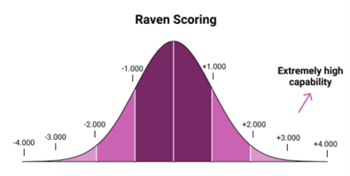
In the second step, your theta score is transformed to percentiles for easier comprehension and comparison after it is calculated. This will be the score displayed in the profile reports.
Ace the Raven’s Test with Focused Practice
Get access to 5 full simulations, 7 practice tests, advanced matrices, and an inductive video tutorial—all designed to help you succeed under real-time test pressure. Enhance your cognitive ability and logic.
Frequently Asked Questions
The Raven's Progressive Matrices (RPM), sometimes known as Raven's Matrices, is a nonverbal exam designed to examine general human intelligence and abstract reasoning abilities. It is similar in nature to other abstract reasoning tests such as the Alva Labs Logic Test and Matrigma.
The test consists of 36 questions you’ll have to answer in 40 minutes. In each question, you’ll see a 3x3 matrix of geometric shapes with one piece missing. Your task is to select the correct tile from a collection of six options to complete the general pattern in the matrix.
The Raven’s test is designed to evaluate how well individuals perceive analogies and reason through visual problems. It is widely used in areas like research, employee selection, and cognitive testing due to its ability to assess thinking skills without relying on language, making it suitable for people from different backgrounds.
Raven's progressive matrices measure general fluid intelligence. A larger number of correct answers than average indicates above-average intelligence, and vice versa.
Due to a lack of cultural bias, Raven's Test is considered a very effective and accurate tool of assessing cognitive thinking and intellectual capacity.
Past versions of the Raven Test were scored by simply counting the correct answers and awarding a point for each. New test versions, however, use a more complex system known as theta sores.
Theta scores range from +4 to -4 (indicating high and low ability, respectively), and take into account not only whether the answer was right or wrong but also the item difficulty and discrimination (difficulty being the portion of people who fail to answer it correctly, discrimination being its ability to differentiate between poor and high performers).
Thus, getting a difficult question right will affect your theta score more than getting an easy question right.
In any case, your theta scores are converted to a percentile rank, which indicates how well you did as compared with your peers. This is the score that will appear on your report. The highest achievable percentile score is 99, which means you are in the top 1% of your norm group.
You can absolutely prepare yourself for the Raven’s APM, and we highly recommend practise before taking it. Many of the Raven questions appear to be difficult at first look, but there are standard rules that repeat throughout the test that you can learn in advance.
Raven's Progressive Matrices is considered a reliable and valid measure of intelligence, particularly fluid intelligence. Studies have shown that the test has high internal consistency and test-retest reliability, meaning that it tends to produce stable and consistent results over time. Additionally, it correlates strongly with other well-established IQ tests, such as the Wechsler Adult Intelligence Scale (WAIS).
However, like any test, it is not perfect. The accuracy can be influenced by factors such as the test-taker's level of concentration, familiarity with similar tests, or test anxiety.
Raven’s Standard Progressive Matrices
The SPM raven test is used when screening entry-level candidates. It is commonly used for positions requiring lateral thinking, decision-making skills and analytical abilities. It has 60 questions that are needed to be completed within 40 minutes. The type of questions in this test is a bit easier than the APM Raven’s test.
Raven’s Colored Progressive Matrices
These matrices were designed for people with general lower ability because of age - very old or young test-takers. It contains the two first sets from the Standard Matrices with an additional set of 12 items inserted in between the two. The questions are presented on a colored background to make them visually stimulating.
Short Advanced Progressive Matrices
The difference between Raven's Advanced Progressive Matrices and the Short APM is the number of questions and the amount of time it takes to finish the test. This simplified version of Raven's intelligence test consists of only 12 questions and must be completed in under 15 minutes.












